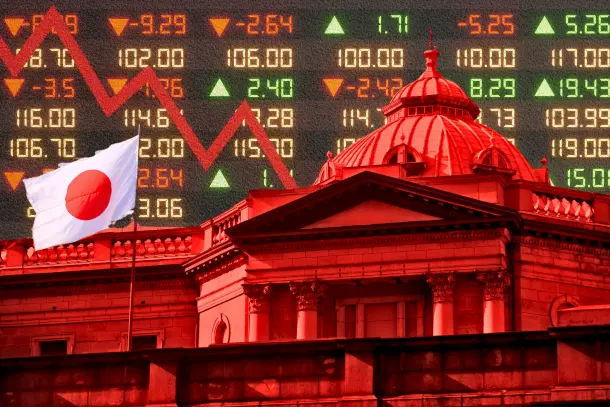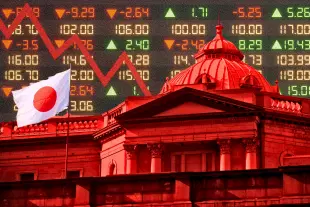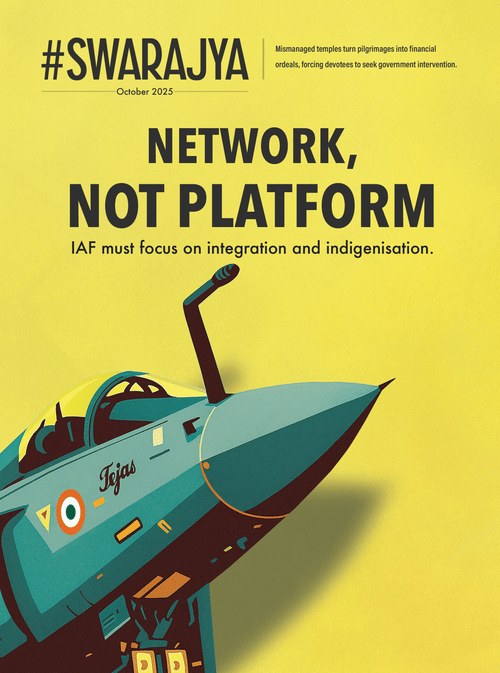Economy
A Great Global Financial Crisis Brewing
Prof. Vidhu Shekhar
Sep 01, 2025, 12:50 PM | Updated Sep 08, 2025, 10:11 AM IST
Save & read from anywhere!
Bookmark stories for easy access on any device or the Swarajya app.


"France may need IMF bailout, warns finance minister" The Telegraph reports. The Wall Street Journal observes "Bail Out France and Britain? You'll Need a Bigger IMF." But here is what these headlines miss: France's crisis is not French; Britain's troubles are not British.
They are symptoms of a global disease that originates in Tokyo, where the Bank of Japan, the world's last vendor of free money, may finally be on the verge of closing shop.
The warning shot came this August. When U.S. Treasury Secretary Scott Bessent publicly scolded the BOJ for being "behind the curve" on inflation, markets shuddered. Within hours, Japanese bond yields climbed, the yen strengthened, and whispers spread that Tokyo could soon trigger tremors throughout global markets.
At first glance, this may look like routine policy friction. Japan's interest rate is just 0.5%, compared to America's 4.5%. Yet beneath the surface lies a fracture that could destabilise the global financial system.
The BOJ is far more central to global finance than many realise. First, it is the last major central bank still clinging to near-zero interest rates. In effect, it remains the world's final source of "free money."
Second, the BOJ now owns about 50% of all Japanese government bonds, an extraordinary concentration that has gutted normal market functioning. Auctions for 30- and 40-year debt have struggled to find buyers, with yields reaching levels not seen since the 1990s.
As the world's last tap of free money, BOJ holds the key to global liquidity. Its $10 trillion government bond market is the world's third largest, and Japanese institutions also hold more than $1 trillion in U.S. Treasuries. If they begin bringing capital home to chase rising domestic rates, they turn into sellers precisely when America needs buyers most.
Washington is running deficits nearing $1.5 trillion a year and must issue more than $1 trillion in new debt per quarter. The collision of record supply with shrinking foreign demand could destabilise bond markets worldwide.
But it is not just Japanese institutions that pose risk. The BOJ's policies also underpin a vast web of global speculation through what is called yen carry trade.
The Carry Trade Time Bomb
The BOJ's ultra-low rates have made it a magnet for global traders. They can borrow yen at near-zero cost, convert it into dollars, and invest across the world in virtually any asset, most of which yield far more than the zero per cent.
This practice, known as the "carry trade," is about as close to easy money as markets get, and it became especially lucrative after Covid.
Post-Covid inflation in US forced the Federal Reserve to finally abandon its Zero Interest Rate Policy (ZIRP), which had been in place since the 2008 Financial Crisis. The Fed began meaningfully raising rates, while the BOJ remained pinned near zero.
That divergence created a textbook free money trade: borrow at 0 to 1% from the BOJ and invest at more than 4% in U.S. Treasuries. Investors did not stop there. They poured the Yen borrowed money into government bonds, technology giants such as the FAANG stocks, and a wide range of other assets, including cryptos. The ease and profitability supercharged the carry trade.
How large are these yen-based investments? Direct private yen carry trades are estimated at $1 to $3 trillion. When the broader overseas investments of Japanese institutions are included, the exposure financed by ultra-cheap yen approaches $20 trillion. More than the GDP of China.
This makes the yen the world's cheapest source of leverage, quietly supporting investments in assets from U.S. Treasuries and tech stocks to debt markets in the EU and emerging economies.
The Last Source of Free Money is About to Dry Up
All this hinges on the BOJ maintaining its near-zero interest rates, which has been showing signs of fatigue over the past couple of quarters.
The gap between BOJ rates and Fed rates, and the resulting carry trade, leaves one important consequence: Japanese inflation.
As carry trades expand, more investors borrow in yen, sell it for dollars, and invest elsewhere. This constant selling pressure drives the yen lower, falling by more than 20% against the U.S. dollar in the last few years.
Japan is heavily reliant on imported resources like energy and food. A falling yen quickly drives up inflation, which is now 3%+. Troubling for an economy which has seen deflation for many decades. The wages are also rising at their fastest pace in decades. This has put tremendous pressure on the BOJ to raise rates.
BOJ responded, but meekly. Even its modest rate increases last year created turmoil in global asset markets, with several very bad days. In July/August 2024 following BOJ tightening, the yen carry trade partially unwound. And Nikkei dropped nearly 20%, S&P 500 by over 6%, and Nasdaq by 7%. August 5, 2024 saw the biggest ever one-day spike in the VIX (Wall Street's "fear gauge"), surpassing previous records from the COVID and 2008 crises.
The question is how long the BOJ can remain cautious, and when it will finally act decisively. That is where the comments of U.S. Treasury Secretary Bessent come in: the BOJ must hike now.
The consequence if it does? A global bond and equity market crash. As the 2024 trailer showed, the enormous carry trade dependent on cheap BOJ liquidity is unlikely to unwind gradually. Instead, it is likely to collapse violently, seizing up global markets.
The mechanism is brutally self-reinforcing: when the BOJ raises rates, investors reverse, selling assets and buying yen to repay loans they borrowed at 0%. This leads to a surge in the yen.
As the yen strengthens, leveraged investors face further losses and must sell more foreign assets to buy yen and cover their debts. That selling pushes the yen up even further, triggering more losses and more selling.
The result is a brutal and rapid meltdown globally as the world is flooded with sellers of every kind of asset, from bonds and equities to cryptocurrencies.
Why Rescue Would Be Difficult This Time
When we compare to the 2008 crisis, one key difference lies in the fact that the crisis was largely an American and European private sector problem: bad mortgages and overleveraged banks. The U.S., and other governments could step in with relatively clean balance sheets to provide rescue.
This time, the problem is government balance sheets themselves. The rescuers from last time are now the ones in trouble.
U.S. federal debt has exploded to unprecedented peacetime levels, with no credible plan for consolidation. Foreign buyers, particularly Japan, have long been essential to financing that borrowing. So have been carry traders.
But if Japanese institutions are forced to repatriate capital, and if carry traders are forced to unwind because of rising BOJ rates and a stronger yen, America and the world could suddenly find themselves without their largest foreign creditor.
Adding to these, Trump's trade war is further compounding the risks. Yale researchers estimate they will raise U.S. prices by nearly 2% in the short term, with much sharper increases in categories like vehicles and apparel.
This puts the Federal Reserve in a spot. In previous crises, the Fed could slash rates to provide relief. But with tariffs driving prices up, aggressive rate cuts risk high inflation expectations.
The Sequence of Destruction
The early signals of crisis are already there. The yield on JGBs (Japanese government bonds), is at 1.60 per cent, not seen since 2008. The difference between JGB yields and U.S. Treasury yields, which indicates the profitability for the carry trade, has narrowed to 2.6%, disturbingly small for the trades to sustain. The impact is already visible, with cracks in global bonds across countries. France, Germany, and the UK all have bond markets under pressure.
The chain reaction is alarmingly easy to imagine. It begins with the BOJ, pressured by sustained inflation, raising rates another quarter-point. A small move in isolation, but symbolically huge as it signals the end of near-free yen. The currency jumps 10 to 15 per cent within days. Leveraged carry traders face margin calls and are forced to liquidate foreign holdings to repay yen loans.
U.S. Treasury yields spike as both Japanese institutions and global traders sell simultaneously. A major Treasury auction could even struggle to attract enough buyers at an acceptable rate. Credit markets freeze. The dollar rises briefly as investors scramble for liquid assets, but then falls as the world realises America cannot finance its deficits without printing money.
Europe is pulled in as well. German Bunds, another safe-haven asset, sell off in tandem with Treasuries. Japanese insurers and pensions also cut their European holdings. Banks, insurers, and pension funds across continents, all loaded with "safest" government bonds, suffer large balance sheet losses.
The Sovereignty Crisis
This will not be a repeat of 2008's banking collapse. It would be a sovereignty and currency crisis, striking at the core assets underpinning the entire financial system.
The very concept of "risk-free" government bonds, the foundation beneath everything from pension savings to bank capital requirements, may be shattered.
When governments themselves become the source of systemic risk, traditional rescue mechanisms fail. Central banks cannot simply bail out sovereigns without jeopardising their currencies.
The IMF also does not have the resources to backstop the United States, Japan, France, and other European countries simultaneously. Wall Street Journal is already saying we would need "a bigger IMF" to handle simultaneous European bailouts.
The consequences would quickly touch households in these countries. Mortgage rates would soar as bond rates spike. Retirement portfolios would fall as both stocks and bonds declined together. Economic growth would weaken as credit costs rose, threatening jobs and business investment. The dollar's reserve currency role may also erode, reshaping trade and finance.
Markets still assume, almost by instinct, that someone will intervene to stop disaster, as governments did in 2008. But this time the governments themselves are the problem.
The global system has piled risk upon risk and leverage upon leverage, all resting on the assumption that sovereign bonds are sacrosanct. That assumption is breaking.
The fuse runs from Tokyo's dysfunctional bond market, through Washington's unsustainable deficits, into the multi-trillion-dollar machinery of the yen carry trade, with the trade wars as icing on the cake. The question is not if, but when.
In all this, however, India, which may be impacted for a while, is perhaps the only major economy that is relatively unleveraged. And therefore, may come through relatively unscathed in a burning world. Perhaps even thrive after initial headwinds. That, though, is another topic for another day.
Dr. Vidhu Shekhar holds a Ph.D. in Economics from IIM Calcutta, an MBA from IIM Calcutta, and a B.Tech from IIT Kharagpur. He is currently an Assistant Professor in Finance & Economics at Bhavan's SPJIMR, Mumbai. Previously, he has worked as an investment banker and hedge fund analyst. Views expressed are personal.





